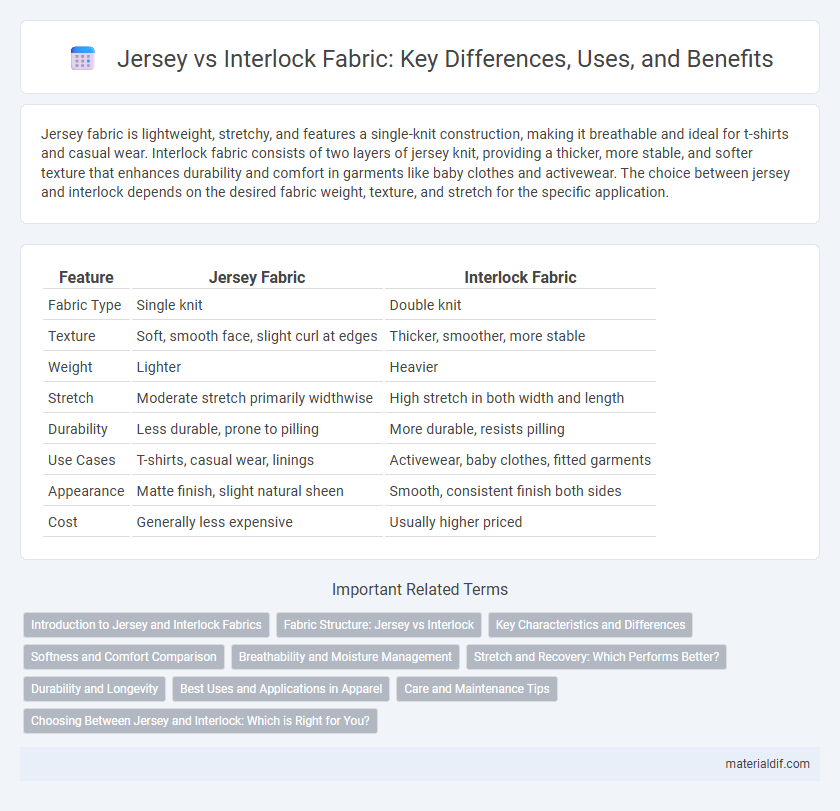Jersey fabric is lightweight, stretchy, and features a single-knit construction, making it breathable and ideal for t-shirts and casual wear. Interlock fabric consists of two layers of jersey knit, providing a thicker, more stable, and softer texture that enhances durability and comfort in garments like baby clothes and activewear. The choice between jersey and interlock depends on the desired fabric weight, texture, and stretch for the specific application.
Table of Comparison
| Feature | Jersey Fabric | Interlock Fabric |
|---|---|---|
| Fabric Type | Single knit | Double knit |
| Texture | Soft, smooth face, slight curl at edges | Thicker, smoother, more stable |
| Weight | Lighter | Heavier |
| Stretch | Moderate stretch primarily widthwise | High stretch in both width and length |
| Durability | Less durable, prone to pilling | More durable, resists pilling |
| Use Cases | T-shirts, casual wear, linings | Activewear, baby clothes, fitted garments |
| Appearance | Matte finish, slight natural sheen | Smooth, consistent finish both sides |
| Cost | Generally less expensive | Usually higher priced |
Introduction to Jersey and Interlock Fabrics
Jersey fabric is a lightweight, stretchable knit textile known for its smooth surface and versatility in apparel like t-shirts and dresses. Interlock fabric is a thicker, more stable knit with two layers of jersey knit interlocked, offering greater durability and a soft, double-sided finish ideal for activewear and baby clothes. Both fabrics are composed primarily of cotton or blends, but differ significantly in texture, elasticity, and use cases.
Fabric Structure: Jersey vs Interlock
Jersey fabric features a single knit structure resulting in a lightweight, stretchy material often with a smooth face and a slightly textured back. Interlock fabric uses a double knit structure, creating a thicker, more stable, and reversible fabric with equal smoothness on both sides. The interlock construction provides enhanced durability and less stretch compared to the more flexible jersey knit.
Key Characteristics and Differences
Jersey fabric is a single-knit material known for its lightweight, stretchy, and breathable properties, making it ideal for t-shirts and casual wear, whereas Interlock fabric is a double-knit textile offering a thicker, smoother, and more stable structure, often used for activewear and baby clothes. Jersey has a natural curl at the edges and stretches mainly in the width, while Interlock provides excellent stretch in both directions with a reversible, smooth surface that resists curling. The durability and opacity of Interlock exceed those of Jersey, making it better suited for garments requiring more structure and resilience.
Softness and Comfort Comparison
Jersey fabric offers a soft, stretchy texture that provides lightweight comfort ideal for casual wear and active lifestyles. Interlock fabric features a thicker, smoother knit with enhanced softness and durability, making it highly comfortable for garments requiring a cozy feel. Both fabrics deliver excellent softness, but interlock's denser structure often results in superior comfort for cooler conditions.
Breathability and Moisture Management
Jersey fabric features a lightweight, open knit structure that enhances breathability and promotes efficient moisture wicking, making it ideal for activewear and warm climates. Interlock fabric, with its denser, double-knit construction, offers moderate breathability but superior moisture retention and durability, providing a balanced feel for cooler conditions. Both fabrics manage moisture effectively, but jersey excels in airflow and quick-drying properties, whereas interlock delivers a more stable, insulating moisture barrier.
Stretch and Recovery: Which Performs Better?
Jersey fabric, known for its single-knit construction, offers excellent stretch but moderate recovery, making it ideal for casual wear and lightweight garments. Interlock fabric, a double-knit material, provides superior stretch recovery and a firmer hand, ensuring durability and shape retention in activewear and structured pieces. When comparing stretch and recovery performance, interlock outperforms jersey by maintaining elasticity longer and resisting sagging or deformation over time.
Durability and Longevity
Jersey fabric offers moderate durability, making it ideal for everyday wear with some resistance to pilling and stretching. Interlock fabric, composed of two layers of jersey knit, provides enhanced durability and superior longevity due to its thicker, tighter weave. The double-knit structure of interlock maintains shape better and withstands frequent washing and abrasion more effectively than single-knit jersey.
Best Uses and Applications in Apparel
Jersey fabric, known for its lightweight stretch and breathability, is ideal for t-shirts, casual wear, and activewear, offering comfort and flexibility. Interlock fabric, thicker and more stable with a smooth surface on both sides, excels in making high-quality baby clothes, leggings, and loungewear that require durability and a polished look. Choosing between jersey and interlock depends on desired fabric weight, stretch recovery, and end-use performance in apparel design.
Care and Maintenance Tips
Jersey fabric, made from single-knit loops, requires gentle washing in cold water and low-heat drying to prevent stretching and pilling; hand washing is ideal for delicate pieces. Interlock fabric, a double-knit material, is more durable but benefits from similar care--machine wash on a gentle cycle and tumble dry on low to maintain its smooth finish and shape. Avoid bleach and use mild detergents for both fabrics to extend their lifespan and preserve softness.
Choosing Between Jersey and Interlock: Which is Right for You?
Jersey fabric offers a lightweight, stretchy, and breathable option ideal for casual wear and activewear, providing comfort and flexibility. Interlock fabric, thicker and more stable with a smoother finish, suits garments that require more structure and durability, such as dresses and fitted tops. Choosing between Jersey and Interlock depends on the desired garment weight, stretch recovery, and texture preferences for your project.
Jersey vs Interlock Infographic

 materialdif.com
materialdif.com